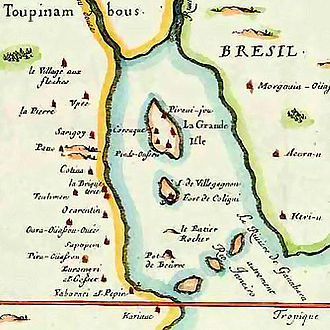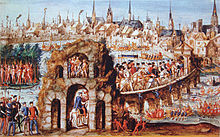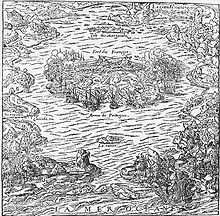
France began colonizing the Americas in the 16th century and continued into the following centuries as it established a colonial empire in the Western Hemisphere. France established colonies in much of eastern North America, on several Caribbean islands, and in South America. Most colonies were developed to export products such as fish, rice, sugar, and furs.

Portuguese colonization of the Americas constituted territories in the Americas belonging to the Kingdom of Portugal. Portugal was the leading country in the European exploration of the world in the 15th century. The Treaty of Tordesillas in 1494 divided the Earth outside Europe into Castilian and Portuguese global territorial hemispheres for exclusive conquest and colonization. Portugal colonized parts of South America, but also made some unsuccessful attempts to colonize North America.

Niterói is a municipality in the state of Rio de Janeiro, in the southeast region of Brazil. It lies across Guanabara Bay, facing the city of Rio de Janeiro and forming part of the Rio de Janeiro Metropolitan Area. It was the capital of Rio de Janeiro, as marked by its golden mural crown, from 1834 to 1894 and again from 1903 to 1975. It has an estimated population of 515,317 inhabitants (2020) and an area of 129.375 km2 (49.952 sq mi), making it the fifth most populous city in the state. It has the highest Human Development Index in the state and the seventh highest among Brazil's municipalities in 2010. Individually, it is the second municipality with the highest average monthly household income per capita in Brazil and appears in 13th place among the municipalities of the country according to social indicators related to education. The city has the nicknames of Cidade Sorriso.
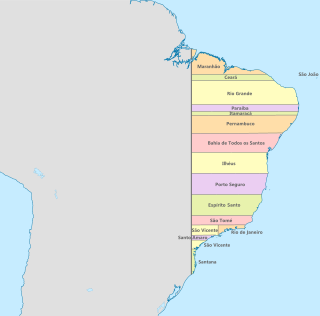
Colonial Brazil comprises the period from 1500, with the arrival of the Portuguese, until 1815, when Brazil was elevated to a kingdom in union with Portugal as the United Kingdom of Portugal, Brazil and the Algarves. During the early 300 years of Brazilian colonial history, the economic exploitation of the territory was based first on brazilwood extraction, which gave the territory its name; sugar production ; and finally on gold and diamond mining. Slaves, especially those brought from Africa, provided most of the work force of the Brazilian export economy after a brief period of Indian slavery to cut brazilwood.

Paubrasilia echinata is a species of flowering plant in the legume family, Fabaceae, that is endemic to the Atlantic Forest of Brazil. It is a Brazilian timber tree commonly known as Pernambuco wood or brazilwood and is the national tree of Brazil. This plant has a dense, orange-red heartwood that takes a high shine, and it is the premier wood used for making bows for stringed instruments. The wood also yields a historically important red dye called brazilin, which oxidizes to brazilein.

Nicolas Durand, sieur de Villegaignon, also Villegagnon was a Commander of the Knights of Malta, and later a French naval officer who attempted to help the Huguenots in France escape persecution.
Mem de Sá was a Governor-General of the Portuguese colony of Brazil from 1557 to 1572. He was born in Coimbra, Kingdom of Portugal, around 1500, the year of discovery of Brazil by a naval fleet commanded by Pedro Álvares Cabral.

The Tupinambá are one of the various Tupi ethnic groups that inhabited present-day Brazil since before the conquest of the region by Portuguese colonial settlers. In the first years of contact with the Portuguese, the Tupinambás lived in the whole East coast of Brazil, and the name was also applied to other Tupi-speaking groups such as the Tupiniquim, Potiguara, Tupinambá, Temiminó, Caeté, Tabajara, Tamoio, and Tupinaé, among others.

Fort Coligny was a fortress founded by Nicolas Durand de Villegaignon in Rio de Janeiro, Brazil in 1555, in what constituted the so-called France Antarctique historical episode.
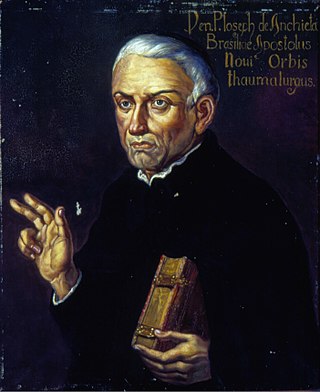
José de Anchieta y Díaz de Clavijo, SJ was a Canarian Jesuit missionary to the Portuguese colony of Brazil in the second half of the 16th century. A highly influential figure in Brazil's history in the first century after its European discovery, Anchieta was one of the founders of São Paulo in 1554 and of Rio de Janeiro in 1565. He is the first playwright, the first grammarian and the first poet born in the Canary Islands, and the father of Brazilian literature. Anchieta was also involved in the religious instruction and conversion to the Catholic faith of the Indian population. His efforts along with those of another Jesuit missionary, Manuel da Nóbrega, at Indian pacification were crucial to the establishment of stable colonial settlements in the colony.

Estácio de Sá was a Portuguese soldier and officer. Sá travelled to the colony of Brazil on the orders of the Portuguese crown to wage war on the French colonists commanded by Nicolas Durand de Villegaignon. These French colonists had established themselves in 1555 at Guanabara Bay in Rio de Janeiro, in a settlement known as France Antarctique. He was the founder of Rio de Janeiro, now the second largest city in Brazil.

Cunhambebe was an Indigenous Brazilian chieftain of the Tupinambá tribe, which dominated the region between present-day Cabo Frio and Bertioga. He lived in a village in Iperoig.
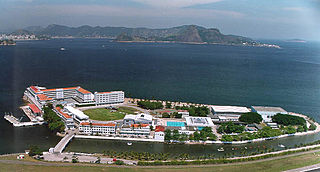
Villegagnon Island is located near the mouth of the large Guanabara Bay, in the city of Rio de Janeiro, Brazil.

Jean de Léry (1536–1613) was an explorer, writer and Reformed pastor born in Lamargelle, Côte-d'Or, France. Scholars disagree about whether he was a member of the lesser nobility or merely a shoemaker. Either way, he was not a public figure prior to accompanying a small group of fellow Protestants to their new colony on an island in the Bay of Rio de Janeiro, Brazil from 1557 to 1558. There he produced the first known transcriptions of native American music: two chants of the Tupinambá, near Rio de Janeiro. The colony, France Antarctique was founded by the Chevalier de Villegaignon, with promises of religious freedom, but on arrival, the Chevalier contested the Protestants' beliefs and persecuted them. After eight months the Protestants left their colony and survived for a short time on the mainland, living amongst the Tupinambá Indians. These events were the basis of de Lery's book, History of a Voyage to the Land of Brazil, Also Called America (1578). Exhausted and starving, they then returned to France aboard a pirate ship.

Several years after the Portuguese first explored Brazil, French traders in search of pau-brasil reached the rich area extending from the Cape Frio coast to the beaches and islands of Guanabara Bay, the economic and, above all, strategic importance of which was already well-known.
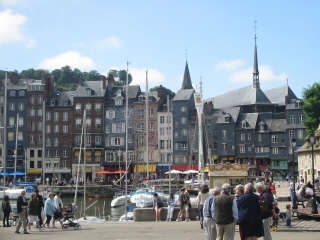
Philippe de Corguilleray, Sieur du Pont, was a Burgundian nobleman who is known for leading a group of Calvinist men from Geneva to the French colony of France Antarctique in Brazil in 1556. The contingent he led included writer Jean de Léry.
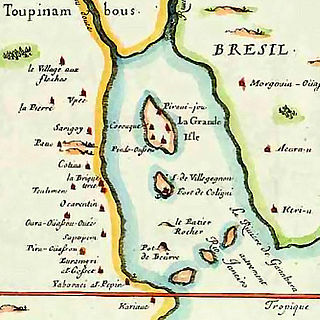
The Battle of Rio de Janeiro was a battle in 1558 on the French town at Rio de Janeiro, called Henriville. The Portuguese, though in far smaller numbers, defeated the French and made them flee to the jungle. The French town was then burnt by Mem de Sá, the Portuguese governor.

Events from the year 1555 in France.

History of a Voyage to the Land of Brazil, Also Called America, is an account published by the French Huguenot Jean de Léry in 1578 about his experiences living in a Calvinist colony in the Guanabara Bay in Rio de Janeiro, Brazil. After the colony dissolved, De Léry spent two months living with the Tupinambá Indians.

French invasions in Brazil date back to the earliest days of Portuguese colonization up until the end of the 19th century.
